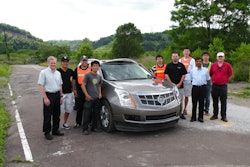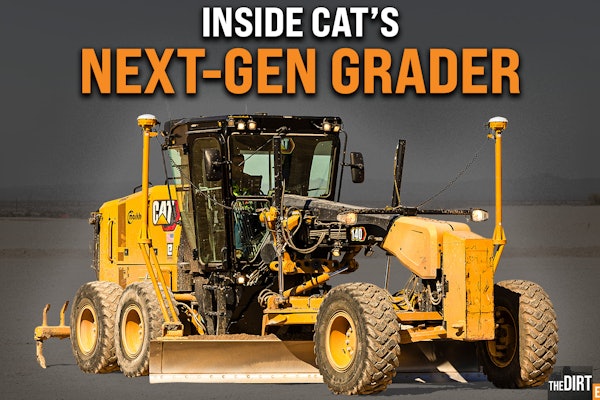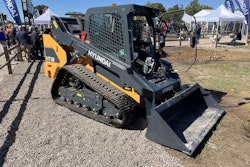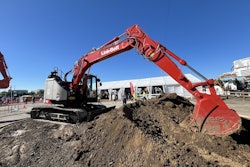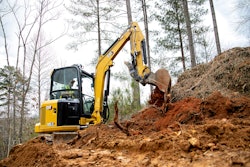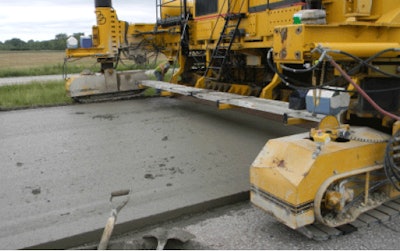
By Daniel C. Brown, Contributing Editor
It took an Illinois contractor eight days of elapsed time to pave a 4-inch concrete overlay on 4 1/2 miles of Illinois 53, a four-lane divided roadway. D Construction, an American Concrete Pavement Association (ACPA) member, placed approximately 125,350 square yards of the concrete overlay this past year on a composite pavement of asphalt over concrete.
“We milled off all of the asphalt in some areas, so in those areas, we were pouring over the old Route 66 concrete,” says Lester Cheney, concrete superintendent for D Construction, Coal City, Illinois. “But we mainly paved over asphalt.
“This was a bonded overlay,” Cheney says. “We had no bond breaker. We cleaned it thoroughly. We had sweepers and laborers with blowpipes hooked to a compressor. We would start early in the morning the day of a pour and let the laborers get a few hundred feet ahead of us. Every day, we were cleaning.”
The contractor paved the two northbound lanes in late May and the two southbound lanes in August. “We were right around 2,000 cubic yards per day,” Cheney says.
A number of factors contributed to the rapid execution of paving for the $3.4 million project, according to Randell Riley, P.E., executive director/engineer for the Illinois Chapter, ACPA. Riley assisted the Illinois Department of Transportation (IDOT) with the design of the 4-inch concrete overlay, which was saw-cut into 4-by-4-foot panels.
Because this was an overlay project, the concrete contained no steel. The contractor added 4 pounds per cubic yard of Grace Construction Products Strux 90/40 synthetic structural fibers and paved 25 feet wide. D Construction’s crews could pick up concrete in end dumps at a central mix plant and discharge directly in front of the paver. There were no dowel baskets to pin to the grade.
D Construction used a GOMACO GHP 2800 paver with Leica Geosystems’ PaveSmart 3D stringless control system. Stringless paving speeds up delivery, eliminates a significant amount of surveying and staking and improves paving accuracy.
“For a paving engineer who has tripped over his share of stringlines during the years, this was nothing short of revolutionary,” Riley says.
The stringless machine control system regulates the steering, grade, draft and crossfall of the paver. The system guides the paver in relation to a digitized 3D model of the highway, running on a computer on-board the paver.
The paver is equipped with two prisms, mounted on the machine, as tracking targets for two robotic total stations. When setting up the robotic total stations, a technician back-sights each of them to four known control points. That fixes the location of the total stations relative to the digital model.
The two total stations follow the movement of the two prisms on the paver and communicate to the machine computer the paver’s precise location via radio link. The machine computer then computes the differences between the paver’s actual location and the digital terrain model. Knowing those differences, the machine computer instructs the paver to regulate the machine in the X, Y and Z directions automatically.
Two additional total stations are set up, one ahead and one behind the paver, to use in checking the new pavement. As the paver passes the next total station in front of it, the crew moves the rear station around in front. That way, the crew “leapfrogs” the total stations down the highway – and the paver never needs to stop. Even in traditional stringline paving, stopping the paver is highly undesirable for mainline paving, as it typically introduces a bump in the surface.
“It was phenomenal – pretty amazing to me,” Cheney says. “I’m an old curb-and-gutter man, and we would always use stringline, so I was somewhat apprehensive. On another IDOT project, we used the stringless control system, and the next day, IDOT was there with a group of surveyors. The slab elevation was amazingly close, like the thickness of a driver’s license. It was right on the money.”
The challenge of the project, Cheney says, was matching new asphalt shoulders that IDOT had placed the year before.
“This is a true concrete ‘mill-and-fill’ project and the first of its kind in Illinois on this scale,” Riley says.







